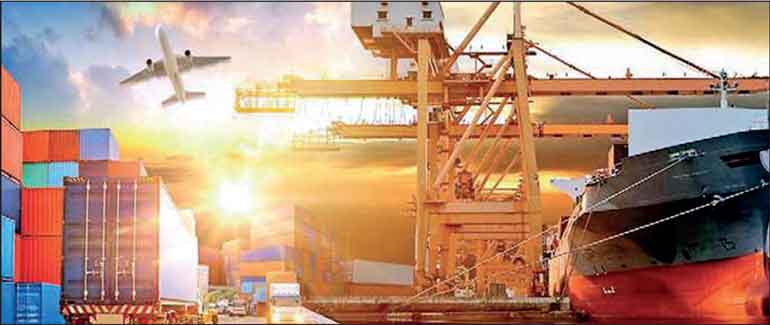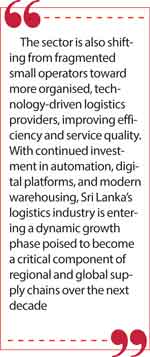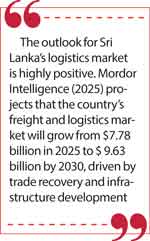Monday Nov 17, 2025
Monday Nov 17, 2025
Monday, 17 November 2025 00:20 - - {{hitsCtrl.values.hits}}

 The logistics sector is a critical determinant of a nation’s economic strength, influencing both microeconomic efficiency and macroeconomic growth by facilitating trade, enhancing supply chain resilience and ensuring the timely delivery of goods and services. In Sri Lanka, the aspiration to establish a prominent regional logistics hub linking international maritime and aviation routes highlights the direct correlation between logistics performance and national economic development. This ambition is especially relevant given the country’s strategic geographical location, which has historically attracted substantial investment and supported significant growth in air and sea connectivity as well as cargo-handling capacity.
The logistics sector is a critical determinant of a nation’s economic strength, influencing both microeconomic efficiency and macroeconomic growth by facilitating trade, enhancing supply chain resilience and ensuring the timely delivery of goods and services. In Sri Lanka, the aspiration to establish a prominent regional logistics hub linking international maritime and aviation routes highlights the direct correlation between logistics performance and national economic development. This ambition is especially relevant given the country’s strategic geographical location, which has historically attracted substantial investment and supported significant growth in air and sea connectivity as well as cargo-handling capacity.
Despite these inherent advantages, Sri Lanka’s logistics sector faces persistent challenges. The country ranked 74th out of 139 in the World Bank’s 2023 Logistics Performance Index, improved from its 92nd position in 2020 but still highlights structural issues within the logistics framework, particularly concerning the quality of trade and transport infrastructure. Such indicators signal the need for a comprehensive analysis to identify underlying bottlenecks and to leverage emerging opportunities for strategic improvement.
The logistics sector plays an essential role in supporting Sri Lanka’s trade, transport, and supply chain management systems. As of 2023, it contributes approximately 1.5% to the national GDP, reflecting its  importance to the economy. Sri Lanka’s strategic location along major international shipping routes makes it a vital regional trade hub, particularly in South Asia. According to the Central Bank of Sri Lanka, freight traffic through the Port of Colombo reached around 7.7 million TEUs (Twenty-Foot Equivalent Units) in 2024 representing a 12.3 % increase from the previous year. The country’s road network spans over 100,000 km, with about 14,000 km of paved roads facilitating domestic distribution. Rapid urbanisation and the rise of e-commerce have further boosted logistics demand, with the sector projected to grow at a compound annual growth rate (CAGR) of approximately 8% over the next five years. However, even with these positive indicators, infrastructure bottlenecks and regulatory barriers continue to constrain operational efficiency.
importance to the economy. Sri Lanka’s strategic location along major international shipping routes makes it a vital regional trade hub, particularly in South Asia. According to the Central Bank of Sri Lanka, freight traffic through the Port of Colombo reached around 7.7 million TEUs (Twenty-Foot Equivalent Units) in 2024 representing a 12.3 % increase from the previous year. The country’s road network spans over 100,000 km, with about 14,000 km of paved roads facilitating domestic distribution. Rapid urbanisation and the rise of e-commerce have further boosted logistics demand, with the sector projected to grow at a compound annual growth rate (CAGR) of approximately 8% over the next five years. However, even with these positive indicators, infrastructure bottlenecks and regulatory barriers continue to constrain operational efficiency.
Challenges facing Sri Lanka’s logistics sector
Sri Lanka’s logistics costs remain significantly high, estimated at 15–18% of GDP, compared to 8–10% in advanced economies. These elevated costs result from structural inefficiencies such as limited multimodal connectivity, traffic congestion, port handling delays, and reliance on outdated logistics infrastructure. Additionally, fragmented supply chains, high fuel prices, and cumbersome customs procedures contribute to increased operational expenses. These inefficiencies not only undermine export competitiveness but also raise the overall cost of doing business. Addressing them through improved infrastructure, digital integration, and streamlined trade facilitation is essential to enhance efficiency and position Sri Lanka as a competitive regional logistics hub.
 Infrastructure remains one of the sector’s most critical challenges. While the Port of Colombo has emerged as a key regional shipping hub with ongoing expansion projects enhancing capacity. many road networks are still inadequate to handle the growing volume of freight efficiently. Poor road conditions and congestion lead to longer transit times and higher transportation costs.
Infrastructure remains one of the sector’s most critical challenges. While the Port of Colombo has emerged as a key regional shipping hub with ongoing expansion projects enhancing capacity. many road networks are still inadequate to handle the growing volume of freight efficiently. Poor road conditions and congestion lead to longer transit times and higher transportation costs.
Regulatory and bureaucratic barriers also constrain development. Complex customs procedures, excessive documentation, and delays at borders increase both time and cost for logistics operators. Ownership restrictions and administrative red tape discourage local and foreign investment, limiting the growth of modern logistics facilities and services.
Economic instability presents another challenge. Currency fluctuations, inflation, and foreign exchange shortages raise the cost of imported equipment and fuel. These conditions discourage private sector investment and drive up operational costs, thereby reducing the sector’s ability to expand and innovate.
Environmental concerns further compound the problem. Rising fuel costs and stricter emission regulations require logistics companies to adopt cleaner but often more expensive technologies. These measures, while necessary for sustainability, can reduce short-term profit margins.
There is a significant shortage of skilled professionals in logistics and supply chain management. This talent gap restricts the industry’s capacity to modernise and adopt advanced technologies, limiting efficiency and innovation. Addressing these infrastructural, regulatory, economic, environmental, and human capital challenges is crucial for building a resilient and competitive logistics sector that supports Sri Lanka’s long-term economic goals.
Regional and global logistics expansion and economic growth
Sri Lanka’s strategic location presents a compelling opportunity to expand regional logistics networks in line with regional and global economic growth. The country is positioning itself to benefit from major initiatives such as China’s Belt and Road Initiative and India’s Act East Policy, aiming to serve as a transhipment and logistics link within Asian supply chains.
The Asia–Pacific region remains the fastest-growing logistics market globally, driving demand for ports, warehousing, and value-added logistics services. Recent multilateral forecasts project South Asia’s growth at around 6% in 2025, moderating to the high 5% range in 2026, while developing Asia overall is expected to grow by around 4%. These trends are expected to increase freight flows across South and Southeast Asia, enhancing demand for transhipment and distribution capacity in hubs like Colombo.
Globally, market studies estimate that the logistics industry will reach between $12.3–12.7 trillion by 2027, with the Asia–Pacific region contributing the largest share. This rapid expansion underscores strong investment interest in port capacity, intermodal transport, and inland logistics facilities areas where Sri Lanka can play a significant role.
Advantages of digitalisation for Sri Lanka’s logistics sector
Digitalisation is reshaping Sri Lanka’s logistics and supply chain landscape by improving transparency, efficiency, and competitiveness. The use of digital platforms for customs clearance, cargo tracking, and documentation has significantly reduced paperwork, processing times, and errors. Initiatives such as Sri Lanka Customs’ paperless declaration system demonstrate the potential for digital workflows to accelerate cargo clearance and enhance coordination among freight forwarders, port operators, and regulators.
 Digital tools such as IoT devices, GPS-enabled fleet systems, and real-time tracking software have improved supply chain visibility and reliability, enabling better customer service and data-driven decision-making. These technologies help companies anticipate disruptions, optimise inventory, and minimise losses.
Digital tools such as IoT devices, GPS-enabled fleet systems, and real-time tracking software have improved supply chain visibility and reliability, enabling better customer service and data-driven decision-making. These technologies help companies anticipate disruptions, optimise inventory, and minimise losses.
Automation in warehousing through electronic invoicing, inventory management, and AI-driven route optimisation has reduced labour costs and boosted productivity. Over time, these efficiencies can significantly lower logistics costs and improve trade competitiveness.
Digital platforms also foster collaboration across the logistics ecosystem. Enhanced data sharing among ports, customs, shipping lines, and inland transport operators enables integrated end-to-end supply chain management. Blockchain technologies further enhance security and transparency in trade documentation, reducing fraud and disputes.
Moreover, digitalisation supports environmental sustainability. Route optimisation and paperless operations reduce fuel consumption and carbon emissions, aligning with Sri Lanka’s green growth objectives. As the nation seeks to establish itself as a regional logistics hub, digitalisation provides the technological foundation for global integration and investor confidence.
Opportunities and future prospects
Sri Lanka is well-positioned to become a leading logistics and maritime hub in the Indian Ocean due to its strategic location along major East–West maritime routes connecting Asia, the Middle East, and Africa. This advantage enables the country to function as a vital transhipment and gateway point for regional and international trade.
The Port of Colombo has undergone significant expansion and modernisation, including new terminals and deeper berths that enhance efficiency and capacity. According to UNCTAD and Research and Markets, the logistics sector already contributes around 2.5% of GDP and provides direct employment to tens of thousands, highlighting its growing importance. Continued infrastructure investments will further strengthen Sri Lanka’s role as a key logistics node in global supply chains.
Looking ahead, the outlook for Sri Lanka’s logistics market is highly positive. Mordor Intelligence (2025) projects that the country’s freight and logistics market will grow from $7.78 billion in 2025 to $ 9.63 billion by 2030, driven by trade recovery and infrastructure development. While road freight remains dominant, segments such as air freight, courier express parcel (CEP) services, and cold-chain logistics are expected to expand rapidly due to e-commerce growth and export diversification. Domestic parcel deliveries increased by 42% in 2023, reflecting the surge in e-commerce demand and the need for efficient last mile delivery solutions. The sector is also shifting from fragmented small operators toward more organised, technology-driven logistics providers, improving efficiency and service quality. With continued investment in automation, digital platforms, and modern warehousing, Sri Lanka’s logistics industry is entering a dynamic growth phase poised to become a critical component of regional and global supply chains over the next decade.
(The author is an economist and a former member of the Sri Lanka Council for Agricultural Research Policy and former director of the Merchant Bank of Sri Lanka and Finance PLC)